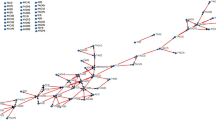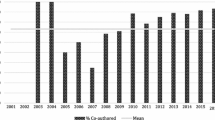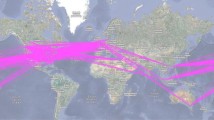Abstract
This article, elaborating on mutuality of knowledge and social structure theory borrowed from sociology of knowledge literature, where knowledge is perceived as an essentially social and societal category, develops a coherent research framework which relates cognitive structure and the collaboration patterns into an integrated socio-knowledge analysis of a given scientific community. The framework extends co-word analysis combining it with social network analysis. The framework is enhanced by introducing a novel model. The new model maps actors from co-authorship networks into a strategic diagram of scientists. The mapping is based on cohesiveness and pervasiveness of issues each author has published in the field. The exemplary longitudinal case from Turkey covers scientific publication activities in Turkish management academia spanning the years from 1922 until 2008. It is seen that, while within local community diffusion of management knowledge is lead by academicians with certain socio-cognitive properties, academicians publishing at international arena do not show any significantly differing socio-cognitive properties, instead, they are merely embedded in strongly connected groups. Leading academicians within local community, however, exhibit a common socio-cognitive structure relative to the rest of the community. They have more social ties and more diversified disseminated knowledge compared to the rest. Knowledge they disseminate is distinct compared to their peers in the network, they hold certain part of their knowledge exclusively, thus knowledge-wise they don’t resemble the rest, but they keep a level of common knowledge with the rest of the community.




Similar content being viewed by others
Notes
Centrality and density metrics of co-word analysis should not be confused with network centrality and network density metrics of traditional social network analysis.
References
Bourdieu, P. (1998). Practical reason: On the theory of action. Palo Alto: Stanford University Press.
Cahlik, T. (2000). Comparison of the maps of science .Scientometrics, 49(3), 373–387.
Calero, C., Buter, R., Valdes, C., Noyons, E. (2006). How to identify research groups using publication analysis: an example in the field of nanotechnology, Scientometrics, 66(2), 365–376.
Callon, M., Law, J., Rip, A. (1986). Mapping the dynamics of science and technology: Sociology of science in the real world. New York: The Macmillian Press Ltd.
Carley, K. M., Reminga, J., Storrick, J., De Reno, M. (2009). ORA User’s Guide 2009, Institute for Software Research, School of Computer Science. Pittsburgh: Carnegie Mellon University.
Collins, R. (1998). The sociology of philosophies: A global theory of intellectual change. Cambridge: Harvard University Press.
Doerfel, M. & Barnett, G. (1999). Application semantic network analysis of the International Communication Association. Human Communication Research, 25(4), 589–603.
Durkheim, E. (1974). Sociology and philosophy. New York: Free Press.
Geisler, E. (2007). A typology of knowledge management: strategic groups and role behavior in organizations. Journal of Knowledge Management, 11(1): 84–96.
Gordon, A. D. (1999). Classification. London: Chapman and Hall.
He, Q. (1999). Knowledge discovery through co-word analysis. Library Trends, 48(1), 133–159.
Hollander, M. & Wolfe, D. A. (1973). Nonparametric statistical methods. New York: Wiley.
Law, J. & Whittaker, J. (1992). Mapping acidification research: A test of the co-word method. Scientometrics, 23(3), 417–461.
Leydesdorff, L. (1992). A validation-study of leximappe. Scientometrics, 24(2), 295–312.
Mannheim, K. (1986). Ideology and utopia : An introduction to the sociology of knowledge. London: Routledge and Kegan Paul.
Merton, R. K. (1968). Social theory and social structure. New York: Free Press.
Mika, P. (2005). Social networks and the Semantic Web: The next challenge. IEEE Intelligent Systems, 20, 82–85.
Morris, S. A., & Van der Veer Martens, B. (2008). Betsy, mapping research specialties. Annual Review of Information Science And Technology, 42, 213–295.
Mutschke, P., & Haase, A. (2001). Collaboration and cognitive structures in social science research fields. Towards socio-cognitive analysis in information systems. Scientometrics, 52, 487–502.
Neff, M. W. & Corley, E. A. (2009). 35 years and 160,000 articles: A bibliometric exploration of the evolution of ecology. Scientometrics, 80(3), 657–682.
Noyons, E. & Calero-Medina, C. (2009). Applying bibliometric mapping in a high level science policy context. Scientometrics, 79, 261–275.
Ozel, B. (2011). Cognitive structures and collaboration patterns in academia. In: E. Noyons, P. Ngulube, J. Leta (Eds.), Proceedings of ISSI 2011. The 13th International Conference on Scientometrics and Informetrics (pp. 638–649). Durban.
Qin, J. (1994). An investigation of research collaboration in the sciences through the philosophical transactions 1901–1991. Scientometrics, 29, 219–238.
Scheler, M. (1980). Problems of a sociology of knowledge. London: Routledge.
Scott, J. (2000). Social Network Analysis: A Handbook. London: Sage.
Tijssen, R. (1993). A scientometric cognitive study of neural network research: Expert mental maps versus bibliometric maps. Scientometrics, 28, 111–136.
Wasserman, S. & Faust, K. (1994). Social Network Analysis. Cambridge: Cambridge University Press.
Whittaker, J., Courtial, J. P. & Law, J. (1989). Creativity and conformity in science: Titles, keywords and co-word analysis. Social Studies of Science, 19, 473–496.
Acknowledgements
An extended version of this article is presented at the 13th International Conference on Scientometrics and Informetrics, Durban (South Africa), 47 July 2011 (Ozel 2011).
Author information
Authors and Affiliations
Corresponding author
Rights and permissions
About this article
Cite this article
Ozel, B. Individual cognitive structures and collaboration patterns in academia. Scientometrics 91, 539–555 (2012). https://doi.org/10.1007/s11192-012-0624-x
Received:
Published:
Issue Date:
DOI: https://doi.org/10.1007/s11192-012-0624-x




